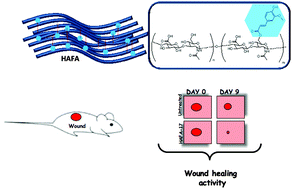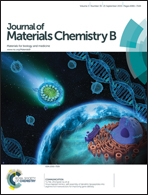Wound healing properties of hyaluronan derivatives bearing ferulate residues
Abstract
HAFA macromolecules were designed as graft copolymers combining ferulic acid (FA) structure and the hyaluronic acid (HA) backbone linked through an ester bond. These materials were prepared by feruloylation of HA with bisimidazolide 3 [i.e. (E)-4-(3-(1H-imidazol-1-yl)-3-oxoprop-1-enyl)-2-methoxyphenyl 1H-imidazole-1-carboxylate] and obtained with different grafting degree (GD) values, which could be tuned by applying suitable reaction conditions. Among the numerous applications envisioned for HAFA graft copolymers on the basis of the physico-chemical, biological, and pharmacological properties of the starting natural products and the grafting-derived features such as physical cross-linking, potential wound healing properties have been evaluated in vitro and in vivo in preclinical models. In human keratinocyte (HaCaT) cells, our data showed the ability of HAFA-17 (GD = 7%) to ameliorate the in vitro scratch wound significantly with respect to the control HA and FA alone, and this effect was associated with the ability of HAFA-17 to also induce keratinocyte proliferation as determined by BrdU assay. In addition, experiments on wound healing in SKH1 mice confirmed the ability of HAFA-17 to improve the wound closure rate also in vivo. Overall, the data presented herein suggest HAFA-17 as a possible future drug for the therapeutic treatment of acute and chronic wounds.


 Please wait while we load your content...
Please wait while we load your content...